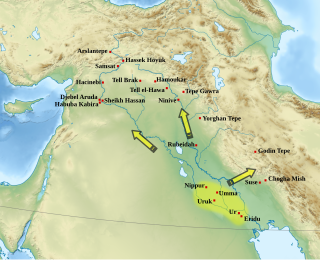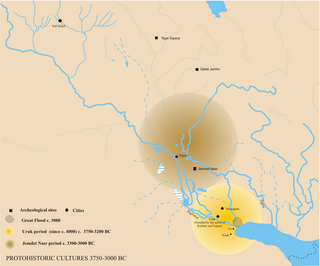Uruk, today known as Warka, was a city in the ancient Near East situated east of the present bed of the Euphrates River on the dried-up ancient channel of the Euphrates. The site lies 93 kilometers northwest of ancient Ur, 108 kilometers southeast of ancient Nippur and 24 kilometers southeast of ancient Larsa. It is 30 km (19 mi) east of modern Samawah, Al-Muthannā, Iraq.

Maya ceramics are ceramics produced in the Pre-Columbian Maya culture of Mesoamerica. The vessels used different colors, sizes, and had varied purposes. Vessels for the elite could be painted with very detailed scenes, while utilitarian vessels were undecorated or much simpler. Elite pottery, usually in the form of straight-sided beakers called "vases", used for drinking, was placed in burials, giving a number of survivals in good condition. Individual examples include the Princeton Vase and the Fenton Vase.
The Ubaid period is a prehistoric period of Mesopotamia. The name derives from Tell al-'Ubaid where the earliest large excavation of Ubaid period material was conducted initially in 1919 by Henry Hall and later by Leonard Woolley.

A bowl is a typically round dish or container generally used for preparing, serving, or consuming food. The interior of a bowl is characteristically shaped like a spherical cap, with the edges and the bottom forming a seamless curve. This makes bowls especially suited for holding liquids and loose food, as the contents of the bowl are naturally concentrated in its center by the force of gravity. The exterior of a bowl is most often round, but can be of any shape, including rectangular.

The Uruk period existed from the protohistoric Chalcolithic to Early Bronze Age period in the history of Mesopotamia, after the Ubaid period and before the Jemdet Nasr period. Named after the Sumerian city of Uruk, this period saw the emergence of urban life in Mesopotamia and the Sumerian civilization. The late Uruk period saw the gradual emergence of the cuneiform script and corresponds to the Early Bronze Age; it has also been described as the "Protoliterate period".

Kraak ware or Kraak porcelain is a type of Chinese export porcelain produced mainly in the late Ming Dynasty, in the Wanli reign (1573–1620), but also in the Tianqi (1620–1627) and the Chongzhen (1627–1644). It was among the first Chinese export wares to arrive in Europe in mass quantities, and was frequently featured in Dutch Golden Age paintings of still life subjects with foreign luxuries.

The Proto-Elamite period, also known as Susa III, is a chronological era in the ancient history of the area of Elam, dating from c. 3100 BC to 2700 BC. In archaeological terms this corresponds to the late Banesh period. Proto-Elamite sites are recognized as the oldest civilization in the territory of present-day Iran. The Proto-Elamite script is an Early Bronze Age writing system briefly in use before the introduction of Elamite cuneiform.

Ding ware, Ting ware or Dingyao are Chinese ceramics, mostly porcelain, that were produced in the prefecture of Dingzhou in Hebei in northern China. The main kilns were at Jiancicun or Jianci in Quyang County. They were produced between the Tang and Yuan dynasties of imperial China, though their finest period was in the 11th century, under the Northern Song. The kilns "were in almost constant operation from the early eighth until the mid-fourteenth century."

Godin Tepe is an archaeological site in western Iran, located in the valley of Kangavar in Kermanshah Province. Discovered in 1961, the site was excavated from 1965 to 1973 by a Canadian expedition headed by T. Cuyler Young Jr. and sponsored by the Royal Ontario Museum. The importance of the site may have been due to its role as a trading outpost in the early Mesopotamian trade networks.

Hanging bowls are a distinctive type of artefact of the period between the end of Roman rule in Britain in c. 410 AD and the emergence of the Christian Anglo-Saxon kingdoms during the 7th century. The surviving examples have mostly been found in Anglo-Saxon graves, but there is general agreement that they reflect Celtic traditions of decoration.

The Jemdet Nasr Period is an archaeological culture in southern Mesopotamia. It is generally dated from 3100 to 2900 BC. It is named after the type site Tell Jemdet Nasr, where the assemblage typical for this period was first recognized. Its geographical distribution is limited to south-central Iraq. The culture of the proto-historical Jemdet Nasr period is a local development out of the preceding Uruk period and continues into the Early Dynastic I period.
Choghā Mīsh (Persian language; چغامیش čoġā mīš) dating back to about 6800 BC, is the site of a Chalcolithic settlement located in the Khuzistan Province Iran on the eastern Susiana Plain. It was occupied at the beginning of 6800 BC and continuously from the Neolithic up to the Proto-Literate period, thus spanning the time periods from Archaic through Proto-Elamite period. After the decline of the site about 4400 BC, the nearby Susa, on the western Susiana Plain, became culturally dominant in this area. Chogha Mish is located just to the east of Dez River, and about 25 kilometers to the east from the ancient Susa. The similar, though much smaller site of Chogha Bonut lies six kilometers to the west.

Grapčeva cave is a Neolithic and Bronze Age archaeological site. Three distinct prehistorical cultures were discovered here: Nakovan, Cetina and Hvar culture.
Zohapilco is in the Central Highlands of Mexico at Tlapacoya Hill, on the edge of Lake Chalco from 5500 – 2200BC. The similar site of Tlapacoya is nearby.

Persian pottery or Iranian pottery is the pottery made by the artists of Persia (Iran) and its history goes back to early Neolithic Age. Agriculture gave rise to the baking of clay, and the making of utensils by the people of Iran. Through the centuries, Persian potters have responded to the demands and changes brought by political turmoil by adopting and refining newly introduced forms and blending them into their own culture. This innovative attitude has survived through time and influenced many other cultures around the world.

The Elmenteitan culture was a prehistoric lithic industry and pottery tradition with a distinct pattern of land use, hunting and pastoralism that appeared and developed on the western plains of Kenya, East Africa during the Pastoral Neolithic c.3300-1200 BP. It was named by archaeologist Louis Leakey after Lake Elmenteita, a soda lake located in the Great Rift Valley, about 120 km (75 mi) northwest of Nairobi.

The art of Uruk encompasses the sculptures, seals, pottery, architecture, and other arts produced in Uruk, an ancient city in southern Mesopotamia that thrived during the Uruk period around 4200-3000 BCE. The city continued to develop into the Early Dynastic Period (Mesopotamia) around 2900-2350 BCE. Considered one of the first cities, the site of Uruk – modern-day Warka in Iraq – shows evidence of social stratification, institutionalized religion, a centralized administration, and what art historians would categorize as high art and architecture, the first in the long history of the art of Mesopotamia. Much of the art of Uruk shows a high technical skill and was often made using precious materials.

Philippine ceramics refers to ceramic art and pottery designed or produced as a form of Philippine art.

Rim-Sîn I ruled the ancient Near East city-state of Larsa from 1758 BC to 1699 BC or 1822 BC to 1763 BC. His sister En-ane-du was high priestess of the moon god in Ur. Rim-Sin I was a contemporary of Hammurabi of Babylon and Irdanene of Uruk.
Hirbemerdon Tepe is an archaeological site in Turkey. The site was inhabited from the Chalcolithic era to the time of the Ottoman Empire. Hirbemerdon Tepe is considered to be an important archaeological site due to its strategic location near agricultural terraces by the Tigris River and local uplands. As a result, archaeologists consider it to provide valuable information on the transformation of the relationship between agricultural communities and nomadic pastoralist societies in northern Mesopotamia. It was excavated from 2003 to 2011, with the majority of archaeological work occurring in 2008. The excavation occurred under the patronage of the Turkish Ministry of Culture and Tourism and in collaboration with the Archaeological Museum of Diyarbakir as well as the Istituto Italiano per l'Africa e l'Oriente.















